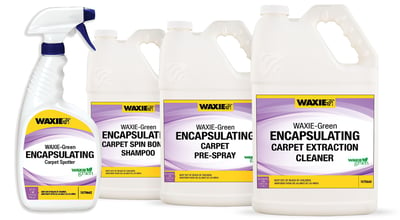
Carpet Care Maintenance
Typical soil particles found deep down between the tufts of carpet—dirt, sand, dust particles, etc. have over 25 different cutting edges. If left in the carpet, these gritty, sharp-edged particles cut, scratch and grind against carpet fibers, causing premature wear. The carpet loses density and resilience and appears dull and faded. Today’s industrial and commercial carpets can outlast and outperform earlier floor coverings if they receive the correct care. But you need to know what you're doing to get the best results.
Most of the soil that can damage carpet comes from three sources: tracked in dirt from the outside, dust and grease settling from the air, and various kinds of spills. Without proper maintenance, these materials combine with normal traffic to wear and tear carpeting. The good news is that most of this soil can be removed—and the life of your carpet extended—with the right equipment and products outlined below.
Carpet Care Preventative Maintenance
Common sense preventive maintenance prolongs carpet life, improves appearance and reduces the need for more complicated maintenance procedures. There are three basic elements to a good preventative maintenance program: using walk-off mats, vacuuming and spot removal.
1.) Walk-Off Mats: Nearly 80% of the soil in carpeting is tracked in from the outside by foot traffic and can be stopped by the proper use of walk-off mats. (Your WAXIE Account Consultant can recommend the right sizes, types, quantities and placement of mats for your needs.) Mats should be kept clean and dry or they become a source of soil and abrasive materials themselves. To maintain the mats, a pressure washer or extractor will do a thorough job of cleaning. Mats should be cleaned at least weekly, more frequently where traffic is heavy. During rain or snow seasons, clean mats with a wet pick up vacuum. Also, do not apply soil protection to mats after cleaning. You want them to attract soil so it doesn’t get tracked onto your carpet.
Click here to view entry and floor mats
2.) Vacuuming: Almost 80% of the soil that gets into carpet can be removed by vacuuming, so it is obviously a key part of your overall maintenance program. For best results, carpet manufacturers recommend frequent vacuuming. They used to solely recommend using a vacuum that uses a revolving brush with its head properly adjusted to the pile height of the carpet. (The brush creates a high speed sweeping action and loosens dirt while the vacuum’s suction removes it. Most commercial vacuums have dual motors to best accomplish this—one to drive the brush and one to create the vacuum suction.) New studies indicate that any vacuum with sufficient suction (airflow-measured as CFM) will remove soil just as well.
Click here to view Windsor Karcher Vacuums
3.) Spot Removal: While many carpets are treated to be stain resistant, no carpet is completely stain proof, so anything spilled on a carpet should be cleaned up promptly. With spot removal, the first step is to scoop up as much of the spill as you can and then absorb as much of the liquid as possible, using paper towels or clean cloths. Use a blotting action to prevent fuzzing the carpet surface and work from the outside in to prevent spreading the spill. The next step is to identify the stain and find the right process to remove it. There are four basic categories of stains: water-soluble (the most common, including mud, ice cream, sugar, etc.); oil-based (including paint, oil, grease, ink, lipstick, etc.); non-soluble (including sand and grit which can be removed by vacuuming); and special treatment (stain requires a specific chemical change for removal, including rust, dye stains, red wine, etc.). Your WAXIE Account Consultant can recommend the right product for each of these types of stains.
Click here to view WAXIE Spotters
Interim Maintenance
While vacuuming removes most dry soils from carpet, oily soils from cooking vapors, air pollution and greasy dirt tracked in from outside attract more dirt and cause colors to dull. If not removed, greasy soil can literally glue carpet fibers together and ruin the carpet. Greasy soil is best removed by water extraction, but fast, light, surface cleaning can be effective using absorbent compound (dry extraction or powder cleaning), bonnet or spin cleaning, or shampooing.
Absorbent compound cleaning involves applying a dry absorbent cleaning compound to the carpet, working it in with a powered brushing system and vacuuming soiled compound and dirt away. Bonnet or spin cleaning uses a rotary floor machine with a bonnet or spin cleaning pad sprayed with or dipped into a bonnet or spin cleaning solution. The pad absorbs soil as it is worked over the carpet in tight, overlapping circles. The pad should be cleaned in cool water as it becomes loaded with soil. (This method is not recommended for some kinds of cut pile carpets).
Click here to view carpet cleaning pads
Shampooing uses either a dry foam shampoo with a shampooing machine or conventional shampoo with a rotary floor machine and carpet brush to work chemical deep into carpet fibers. Suspended soil and residue are then wet-vacuumed away.
Surface Extraction
New technologies have made soil extraction the preferred method for both interim carpet maintenance and restorative cleaning. There are three basic types of extractors: truck-mounted units with long hoses and some type of carpet wand or tool; portable tank-style or “box” units with hoses and a wand or tool; and portable, self-contained units.
Click here to view Extractors
An extractor sprays cleaning solution into the carpet. Normally the solution is worked in with a rotating brush to dislodge dirt. Then dirt and solution are lifted out through a vacuum head. This method is very effective and leaves little residue. An operator with a modern extractor can clean up to 18,500 square feet per hour in the low-moisture mode, or up to 8,000 square feet per hour in the restoration mode.
Deep Extraction
Even when carpets become heavily contaminated with soils, they can usually be restored to good condition with deep extraction. Deep extraction may also improve the general appearance and delay replacement of damaged carpet. This method is very similar to surface extraction, but the equipment is used at a slower cleaning rate.
For all interim or restorative methods, you should first vacuum the area and treat spots with spot removers. For best results, traffic lanes and heavily soiled areas should be treated with a pre-spray or pretreatment to loosen and emulsify tough soils and improve the effectiveness of the cleaning process.
Your WAXIE Account Consultant can provide additional information about the techniques discussed here and make product and equipment recommendations for your specific requirements.




